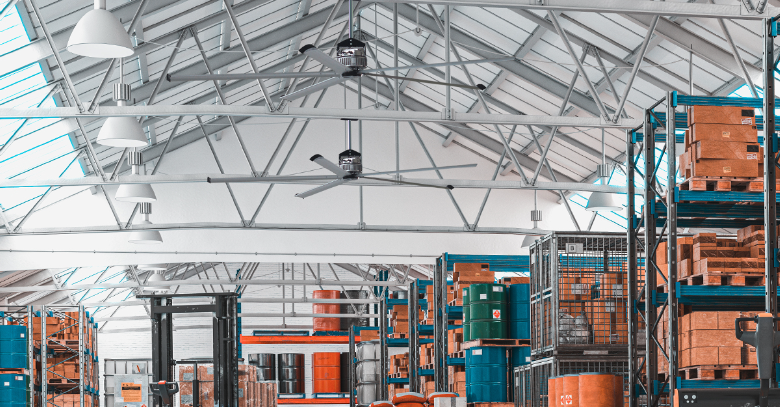
Industrial fans are essential equipment used in various industries to move air and other gases for ventilation, circulation, and drying. These powerful machines come in various types and sizes to meet the specific needs of different applications.
This blog will give a low down on the different types of industrial fans, their design and construction, and their various applications. We will also discuss choosing the right industrial fan for a particular application and how to maintain these machines properly.
Types of Industrial Fans
There are many fans, but they are split into three categories: centrifugal and axial.
#1 Axial Fans
Axial fans are popular for their ability to move large volumes of air at relatively low pressures. They work by using a series of blades mounted on a rotating shaft to draw in air and push it out in the same direction as the blades are rotating. You can use them in ventilation systems and air conditioning units, and they are typically more efficient than centrifugal fans at moving air over long distances. Examples of axial fans include propeller fans, axial tube fans, and axial vane fans.
#2 Centrifugal Fans
Centrifugal fans are designed to move air at higher pressures and are often used in industrial processes and air handling systems. They work by using a spinning impeller to draw in air and accelerate it through a diffuser, which converts the kinetic energy of the moving air into pressure.
Centrifugal fans are typically more efficient at moving air at higher pressures and over shorter distances than axial fans. They include forward-curved fans, radial fans, and backward-inclined fans.
Industrial Fan Design and Construction
Industrial fans are made from various materials, including metals, plastics, and composites. The choice of material depends on the application’s specific requirements, such as the temperature and corrosion resistance needed.
Industrial fans are also constructed using several methods, including welding, casting, and injection moulding. The design and construction of industrial fans can significantly impact their performance and suitability for different applications.
Industrial Fan Applications
You can use industrial fans for various applications, including ventilation, air circulation, and drying.
In ventilation systems, industrial fans bring fresh air into a space and remove stale air. This is important for maintaining air quality and preventing the buildup of harmful gases or pollutants. You can also use them to ventilate many spaces, including homes, offices, factories, and warehouses.
In air circulation systems, industrial fans distribute air evenly throughout a space, such as in a warehouse or factory. This helps to maintain a comfortable environment and prevent the buildup of hot or cold spots. They are also used to circulate air in large outdoor spaces, such as sports stadiums or arenas.
Besides that, they are also used in drying applications to remove moisture from materials or surfaces. This can be important in textiles, paper, and food processing industries, where excess moisture can lead to product degradation or spoilage.
Industrial Fan Selection
Choosing the right industrial fan for a particular application can be challenging. Here are several factors to consider:
- Size and layout of the space: The size and layout of the space that requires ventilation will determine the airflow requirements for the fan. Selecting an appropriately sized fan for the space is crucial to ensure optimal performance.
- Type of material you want to move: The material you want to move, such as air or gas, will determine the most suitable fan type. Different types of fans are better suited for moving various materials, so consider this when selecting a fan.
- Desired airflow: The desired airflow, or volume of air that requires moving, will also impact the selection of the fan. You must select a fan that can meet the airflow requirements of the application.
Other factors to consider when selecting an industrial fan include the pressure required, the operating environment, and any specific requirements such as temperature or corrosion resistance.
Industrial Fan Maintenance
Proper maintenance of industrial fans is essential to ensure their long-term operation and performance. This could include cleaning the fan blades and inspecting and replacing worn parts.
- Inspecting and replacing worn parts: Over time, the various parts of an industrial fan can wear out and need replacing. This can include things like bearings, seals, and motor components. Regularly inspecting the fan for worn parts and replacing them as needed can help extend the fan’s life and prevent costly downtime.
- Ensuring that the fan is appropriately aligned: Proper alignment of the fan is vital for optimal performance and efficiency. Misalignment can cause the fan to vibrate or make noise, reducing the fan’s life. It is critical to regularly check the alignment of the fan and make any necessary adjustments.
Industrial fans are essential equipment used in various industries for ventilation, air circulation, and drying. Understanding the different types of industrial fans, their design and construction, and their applications can help you choose the right fan for your needs and properly maintain it to ensure optimal performance. Industrial fans can meet your needs, whether you want to ventilate a small space or circulate air in a large warehouse.
If you need industrial fans for your business, consider reaching out to Refresh Fans. With a wide range of high-quality industrial fans and experienced professionals to assist you, we can help you find the perfect solution for your needs. Contact us today for more information or to request a quote.